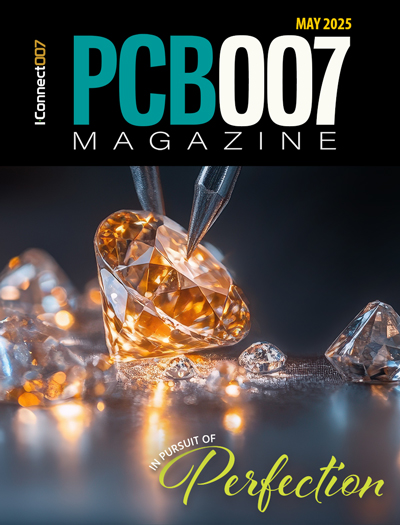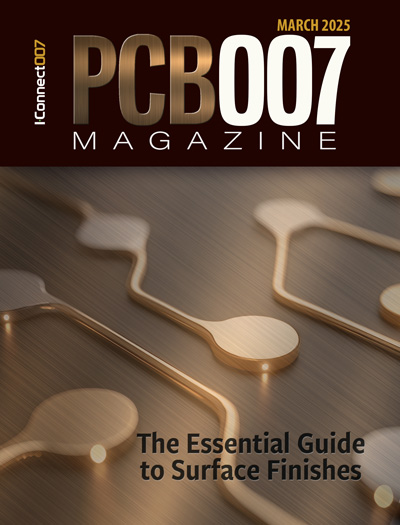-

- News
- Books
Featured Books
- pcb007 Magazine
Latest Issues
Current Issue
In Pursuit of Perfection: Defect Reduction
For bare PCB board fabrication, defect reduction is a critical aspect of a company's bottom line profitability. In this issue, we examine how imaging, etching, and plating processes can provide information and insight into reducing defects and increasing yields.

Voices of the Industry
We take the pulse of the PCB industry by sharing insights from leading fabricators and suppliers in this month's issue. We've gathered their thoughts on the new U.S. administration, spending, the war in Ukraine, and their most pressing needs. It’s an eye-opening and enlightening look behind the curtain.

The Essential Guide to Surface Finishes
We go back to basics this month with a recount of a little history, and look forward to addressing the many challenges that high density, high frequency, adhesion, SI, and corrosion concerns for harsh environments bring to the fore. We compare and contrast surface finishes by type and application, take a hard look at the many iterations of gold plating, and address palladium as a surface finish.
- Articles
- Columns
Search Console
- Links
- Media kit
||| MENU - pcb007 Magazine
Trouble in Your Tank: Acid Copper Plating
February 6, 2017 | Michael Carano, RBP Chemical TechnologyEstimated reading time: 1 minute
Introduction
Electroplating a printed circuit board is by no means a trivial task. Higher layer counts, smaller-diameter vias (through-hole and blind) as well as higher-performance material sets contribute to the greater degree of difficulty with today’s technology. So, process engineers pay close attention to the “softer” issues such as cathode current density, solution chemistry (copper sulfate and sulfuric acid concentration) and addition agent control (well, sometime!).
The concern here is that acid copper pattern plating of a printed circuit board has many more critical aspects that must be diligently controlled for optimum performance. These include solution agitation and filtration, anode length and placement, current distribution effects, reducing electrical resistance in the plating cell, photoresist development and controlled organic contamination in the plating solutions. These are the subjects of this article.
Solution Agitation
For uniform surface plating distribution, a homogeneous mixing of the electrolyte is necessary to avoid overplating the surface while the through-hole or blind via is being plated from the bottom up. The engineer should adjust flow rates so as to not create an excessively turbulent solution movement.
Solution agitation of the copper plating electrolyte maybe accomplished with air agitation, eductors, solution impingement and/or cathode bar movement. The main purposes of agitation have been stated many times and include:
- Elimination of solution stagnation and dispersal of reaction products
- Increase of deposition rates by mass transfer enhancement
- Dissipation of heat at electrode/solution interfaces
To read the full version of this article which appeared in the January 2017 issue of the PCB Magazine, click here.
Suggested Items
Preventing Surface Prep Defects and Ensuring Reliability
06/10/2025 | Marcy LaRont, PCB007 MagazineIn printed circuit board (PCB) fabrication, surface preparation is a critical process that ensures strong adhesion, reliable plating, and long-term product performance. Without proper surface treatment, manufacturers may encounter defects such as delamination, poor solder mask adhesion, and plating failures. This article examines key surface preparation techniques, common defects resulting from improper processes, and real-world case studies that illustrate best practices.
RF PCB Design Tips and Tricks
05/08/2025 | Cherie Litson, EPTAC MIT CID/CID+There are many great books, videos, and information online about designing PCBs for RF circuits. A few of my favorite RF sources are Hans Rosenberg, Stephen Chavez, and Rick Hartley, but there are many more. These PCB design engineers have a very good perspective on what it takes to take an RF design from schematic concept to PCB layout.
Trouble in Your Tank: Causes of Plating Voids, Pre-electroless Copper
05/09/2025 | Michael Carano -- Column: Trouble in Your TankIn the business of printed circuit fabrication, yield-reducing and costly defects can easily catch even the most seasoned engineers and production personnel off guard. In this month’s column, I’ll investigate copper plating voids with their genesis in the pre-plating process steps.
Elephantech: For a Greener Tomorrow
04/16/2025 | Marcy LaRont, PCB007 MagazineNobuhiko Okamoto is the global sales and marketing manager for Elephantech Inc., a Japanese startup with a vision to make electronics more sustainable. The company is developing a metal inkjet technology that can print directly on the substrate and then give it a copper thickness by plating. In this interview, he discusses this novel technology's environmental advantages, as well as its potential benefits for the PCB manufacturing and semiconductor packaging segments.
Trouble in Your Tank: Organic Addition Agents in Electrolytic Copper Plating
04/15/2025 | Michael Carano -- Column: Trouble in Your TankThere are numerous factors at play in the science of electroplating or, as most often called, electrolytic plating. One critical element is the use of organic addition agents and their role in copper plating. The function and use of these chemical compounds will be explored in more detail.


